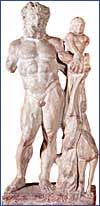
Ancient Period
In c. 600 B.C. the Thracian-Cimmerian and Scythian tribes moved across this area, while the Celtic tribes crossed this territory in the III century B.C. The founding of Singidunum is attributed to the Celtic tribe, the Scordiscs. As a fortified settlement, Singidunum was mentioned for the first time in 279 B.C. The first part of the word - Singi - means "round" and dunum means "fortress" or "town". It is possible that the name originated from the name of the Thracian tribe, the Sings, which was settled on this area when the Celts came. There are almost no traces about that Celtic town, except the necropolises found at the Karaburma and Rospi Ćuprija locations. These contained valuable artistic artefacts, that belong to the warriors of the Scordiscan tribe. A considerable Celtic cultural influences have been woven into the spiritual culture of the Singidunum inhabitants, and later mixed with Roman classical cultural elements.
The Romans conquered Belgrade in the beginning of the I century A.D. and it has been under their rule for full four centuries. The soldiers of the Moesian legions made the first Roman garrison in Singidunum. The well-shaped graves found at Trg Republike and other locations in the city date from this period. A part of the Roman Empire, beside Singidunum, was Taurunum, today's Zemun. Both of these towns have become important military strongholds on the fortified Roman border - the "limes".
Singidunum was most prosperous in 86 A.D., when the IV Legion of Flavius arrived. The first stone fortress in Upper Town was constructed then. Its fragments can be noticed even today. That "castrum" (fort) was square-shaped and covered the area of today's Upper Town of Kalemegdan. During its development, Singidunum has overgrown its status of a "municipium" and become a colony of the Roman citizens. The shape of Taurunum (Zemun) of that period is not well known; it was probably located at the place of today's Lower Town. As an important Roman military camp, Singidunum gained municipal rights in the II century A.D. during the rule of emperor Hadrian. Its military importance became even higher in the III century, when the emperor Aurelian left Dacia and Upper Moesia gained new borders along the right bank of the Danube. In that period, Singidunum was the center of the Christian diocese. Some time later, it was the place of birth of the Roman emperor Flavius Jovianus.
Next to the military camp, the Romans settled veterans of their legions in order to strengthen their border even more. In time, a quite large settlement came into existence, having a rectilinear base, with streets intersecting at right angle. Some of the bases of these urban elements are preserved until today, which can be seen in the orientation of the Uzun Mirkova, Dušanova and Kralja Petra I streets. The Student's square (former Roman forum with thermae, discovered some 30 years ago) has also preserved this rectangular shape.
Between Singidunum and Taurunum, there was a bridge over the Sava, which connected the two towns and which was a part of one of the most important Roman roads. Thus, Singidunum became an important crossroad for the Roman provinces of Moesia, Dacia, Pannonia and Dalmatia. The military road - Via Militaris, which went from the west to the east, through Sirmium (Sremska Mitrovica), Singidunum and Viminacium (Kostolac), to Byzantium, was protected by forts. These forts also existed in the area of today's Belgrade. Some of them were: Mutatio ad Sextum (Mali Mokri Lug), Castra Tricornia (Ritopek), Mutatio ad Sextum Militare (Grocka), and others. The road connecting the miner's settlements on Avala, Kosmaj and Rudnik. Some more important remains of material culture (tombs, monuments, sculptures, ceramics, coins) have been found in many villages in the vicinity of Belgrade.
After the division of the Roman Empire into the Western Roman Empire and Eastern Roman Empire in 395, Singidunum became a border town of the Byzantine Empire. This new position of the town determined its later fate, for it became not only a linking point of various cultural influences, but, before all, a communication and strategic key of the Byzantine Empire.

